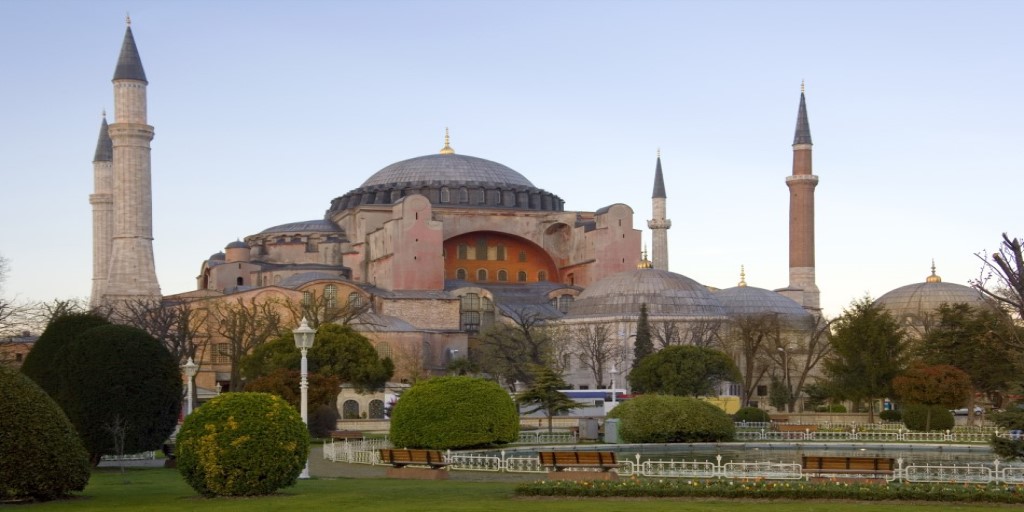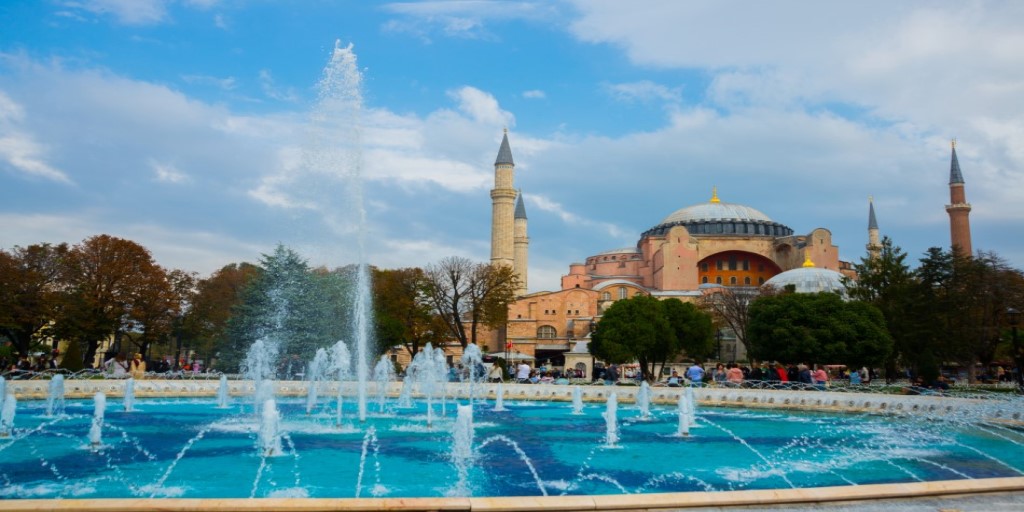Hagia Sophia In Istanbul-Turkey
Hagia Sophia, a remarkable achievement in the history of architecture. A living proof of mankind’s revolt against the laws of physics. A monument whose importance transcends borders. As one of UNESCO’s World Cultural Heritage sites, Hagia Sophia continues to attract millions with its majestic grandeur and beauty.

BIRTH OF THE HAGIA SOPHIA
As founder of the Byzantine city of Constantinople, the emperor Constantine made many significant changes to the metropolis but credit for the original Hagia Sophia goes to his son, Constantinus. Unfortunately, in 404, the wooden roof building burned to the ground and the Nika rioters torched the second Hagia Sophia in 532.
Emperor Justinian inaugurated the current version of the Hagia Sophia in 537 and in real style; he covered the interior with magnificent mosaics. Without a doubt, he wanted everyone to admire his creation and also ordered his architects to source the finest stones and thousands of skilled workers from around the globe. This included transporting and using massive columns from the ancient Temple of Artemis near Ephesus that was one of the seven wonders of the ancient world.
He also had superstitious beliefs in the abilities of the building as depicted in the sweating pillar. Apparently, when he had a migraine, he rested this head against this post that miraculously cured it. No matter what his beliefs were, Justinian had built the largest domed building in the wall and quietly prided himself on making it grander, bigger and better than the vast temple of Jerusalem.
CONVERSION TO A MOSQUE BY MEHMET THE 2ND
The glory Byzantine days of the Hagia Sophia ended in 1453 when the Ottoman Sultan Mehmet the 2nd captured Constantinople. Immediately upon entering the city, he rode to the Hagia Sophia, stopped the looting and vandalizing of soldiers, and ordered its conversion into a mosque.
Legends say he dismounted his horse at the entrance doors and sprinkled a handful of soil over this turban, signifying his obedience to God. His architects added four minarets, plastered over the Byzantine mosaics, and removed holy relics. At the time of the invasion, soldiers called the Hagia Sophia, the church of the infidels, yet Mehmet had secured its future by converting it into an imperial mosque for the next 482 years.
INSIDE THE HAGIA SOPHIA MUSEUM
The Ottoman Empire enjoyed many fruitful years in Constantinople, yet at the beginning of the 20th century, they were crumbling and eventually disbanded for Turkey to become a republic. On February the 1st 1935, Mustafa Kemal Ataturk, the founder of the modern-day Turkish Republic declared the Hagia Sophia to be a national museum.
Painstaking and intense work uncovered much of the original mosaics and one of the finest is at the entrance of the old imperial door previously confined to use by the emperor and his entourage only. Showing Christ on a throne and emperor Leo kneeling next to him, historians have dated it to 886 making it a highly prized and valuable artifact. Another extremely impressive mosaic is of the Virgin Mary holding the baby Jesus. Also dating from the 9th century, it adorns the large dome.
Without a doubt, the vast space projected by the large dome reaching 56 meters from the ground astounds everyone. Best viewed from the upper gallery, space is even more emphasized by the large 8-meter diameter Islamic calligraphy plaques adorning the naves. Bearing the names of Allah and other prophets, they represent a peaceful union when sitting inside a building of ancient Christian mosaics.
Several other points within the interior are magnificent including the Hellenistic large marble urns in the western corners, and the mihrab facing in the direction of Mecca. Directly to the left of this is the seating area for the sultans and to the right is the excellently preserved minber, where the imam stands to deliver sermons. Installed by Murad the third in the 16th century, it is a beautiful example of Ottoman workmanship. Nearby the coronation square is where the Byzantine emperor’s Thrones would have been.
THE SULTANS TOMBS
The interior is the most impressive part of the Hagia Sophia, but its exterior courtyards are also significant. Containing tombs of various sultans including Selim the 2nd and Murad the 3rd, and holding 42 sarcophagi, they are certainly elaborate and befitting of great leaders. More importantly, though, they prove the Hagia Sophia’s importance as one of the most significant landmarks, not just of Istanbul but also in the world.
Interesting Facts about the Hagia Sophia of Istanbul
In Turkish, it is called Ayasofya
The name Hagia Sophia means the Church of Holy Wisdom
The plaques of Islamic calligraphy were added in the 19th century and are made from wood
Visiting The Hagia Sophia
Before going inside the Hagia Sophia, it’s a good idea to walk around the building on the outside and get a better look at the huge dome, buttresses, and minarets.
The scale of these is enormous, and one of the best viewpoints for taking photos is at the fountain in the middle of Sultanahmet Square.

On the Hagia Sophia grounds, you can also visit the tombs of the Sultans, a group of 3 smaller domed buildings with intricate Islamic motifs and writing.
The Hagia Sophia was used as a church for 916 years
It was then converted into a mosque in 1453 and used as such for 482 years
In 1935, it become an official museum of the Turkish Republic
It belongs to the old part of the city that is listed on the UNESCO World Heritage list.
There are two floors; the ground and upper gallery levels. The latter is reached by an uneven, winding stone staircase so make sure you have good shoes on!
We design different Turkey Package Tour for different types of tourists.